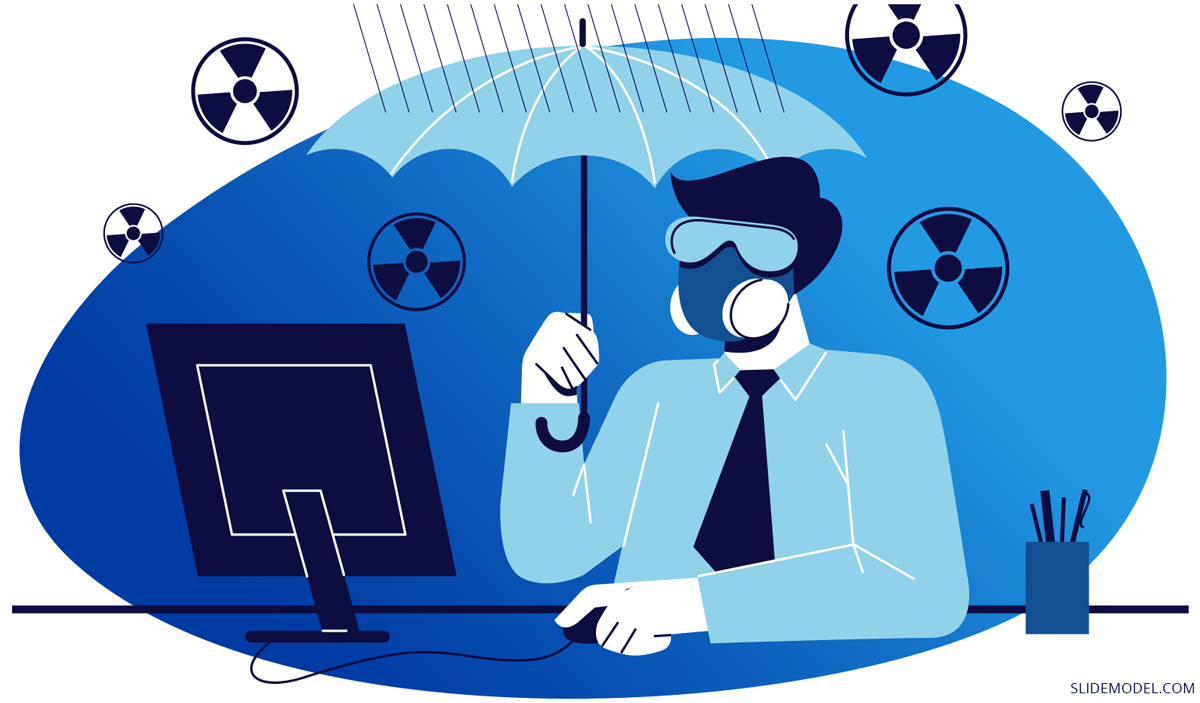
When it comes to leadership, the general idea is to often discuss aspects such as what makes a good leader or how can a leader be effective at the workplace? There are many articles centered around what can be deemed as a discussion about ‘good leadership’. However, when following the bandwagon of leadership topics, many people fail to discuss or even acknowledge one of the biggest ailments’ employees suffer at the workplace in the form of toxic leadership. In order to understand not only leadership but the failure of employees to deliver, it is important to analyze toxic leadership at the workplace or the factors which make a toxic leader? This can help better understand if a failure of leadership is to blame for the lackluster performance of employees at the workplace.
- What is Toxic Leadership?
- What are the Traits of a Toxic Leader?
- Possible Causes of Toxic Leadership?
- How to Handle a Toxic Work Environment?
- What to do if I am the Toxic Leader?
- Final Words
What is Toxic Leadership?
Toxic leadership occurs when an individual in a leadership role abuses his/her authority by violating the leader/follower relationship through unfair practices. A toxic leader is selfish and self-destructive; destroying corporate structures for personal gains or to satisfy his/her ego. The term ‘toxic leader’ was coined is often associated with various dysfunctional styles of leadership. The phrase is attributed to Marcia Lynn Whicker, who coined the term in 1996. Marcia in her book titled ‘Toxic Leaders: When Organizations Go Bad’ described three distinct leadership types, including trustworthy, transitional and toxic leadership styles.
What are the Traits of a Toxic Leader?
In 2018 a workforce consulting firm by the name of ‘Life Meets Work’ released a report titled ‘Toxic Leadership: The Most Menacing Form of Leadership’. The report released various menacing toxic leadership statistics including the revelation that 56% of employees in the United States have to deal with toxic leadership and a resulting obnoxious workplace environment. The report also mentioned that 73% of employees had claimed to have worked with a toxic boss, leading to traumatic experiences at the workplace.
While there is no finite list of traits that can describe toxic leadership, we can summarize the traits of a toxic leader with the following attributes which should be sufficient for at least a basic understanding and analysis of the topic.
1. Oppositional Behavior
The toxic leader often demonstrates oppositional behavior, undermining subordinates, rejecting good work by labeling it as inadequate or flawed and making his team feel less than inadequate based on frivolous assumptions.
2. Overly Competitive Attitude
At the first sign of a competent subordinate, the toxic leader displays an overly competitive attitude to show that he/she is better. This attitude is not just present in work-related activities but also in personal life. If a subordinate appear happy or qualified due to personal achievement, the toxic leader will try to show that he/she is better than him/her, even if it means showing an inflated sense of achievements or by maintaining a glorified false image.
3. Blaming Others
The toxic leader never likes to admit his/her mistake and likes to gaslight others to elude accountability by blaming someone else for mistakes made due to incompetence, negligence or lack of foresight.
4. Power Politics
Many toxic leaders are promoted to important positions based on their power politics. Such individuals engage in strong lobbying, often at the cost of the well-being of the organization and its employees. Power politics results in undermining individuals which might seem like an active threat to discredit them. The objective is to reduce the influence of the opposition or create an environment where anyone who is deemed as a threat finds it hard to survive within the organization. Many individuals who fall victim to this type of politics are either terminated, resign or work under stressful circumstances. The toxic leader when engaging in power politics can stoop to any level and even engage in bribery, blackmail, false allegation, etc.
5. Narcissism
Toxic leaders are narcissistic, often depicting aggressive narcissism. This can be characterized as a lack of remorse, callousness, failure to accept responsibility, superficial charm, grandiosity and indulgence in pathological lying.
6. Abuse of Disciplinary System
While toxic leaders might be the first to use the disciplinary system against their opponents, they are also the most likely to abuse the system. This might include finding a way around the system to cover their own misconduct or abuse of power, as well as to use the disciplinary system through manipulation to take out the opposition, even if it means leveling false charges.
7. Condescending and Glib Attitude
Toxic leaders have a condescending and glib attitude. They find pleasure in degrading others and bringing down colleagues and subordinates for some sense of self-satisfaction. They often try to lure people with superficial charm, with a grandiose sense of self-worth.
8. Lacks Self-Confidence
Contrary to the false image created by the toxic leader, he/she lacks self-confidence. Such an individual often gets exposed in the presence of a competent team or coworker. In such a case the toxic leader can often panic and might even try to make up for the embarrassment later on by verbally and mentally abusing subordinates to make up for the sense of loss of self-esteem.
9. Poor Self-Control
A lack of self-control is one of the best indicators of inadequate leadership. Leaders exhibiting toxic behavior have poor self-control, are irritable and like to act on their impulses. This behavior is often not limited to subordinates and the workplace but also in personal life.
10. Physical and/or Psychological Bullying
A team that is always stressed, scared and lacks confidence is a good indicator that the one leading the team is exhibiting toxic behavior. Psychological and sometimes even physical bullying is common by toxic leaders. The latter can include pushing someone around, uncomfortable body contact such as pointing a finger right at someone’s face and in extreme cases, violent behavior causing physical injuries or bruises. Bullying is an important pastime of the toxic leader, as it gives him/her the feeling of control and grandiose that is essential for nurturing the false image created by such individuals.
11.Procedural Inflexibility
Many organizations and researchers have spent several years finding efficient procedures to improve productivity, employee satisfaction and boost revenue. The toxic leader on the contrary is often bound by procedural inflexibility. This is often due to incompetence and fear of losing control under an efficient system.
12. Discriminatory Attitudes
Nepotism is often what leads one toxic leader to promote another. Such individuals are often charmed by silver-tongued subordinates who have nothing better to do than to feed the ego of the toxic leader in the hope of gaining favors in return. This leads to discriminatory behavior and promotion of incompetent individuals ahead of deserving employees. Furthermore, many toxic leaders flout rules to hire and promote their own friends, family members and others they might be biased enough to favor.
13. Workplace Division Instead of Harmony
Toxic leaders have a strong sense of ‘divide and rule’. They exhibit this behavior with coworkers, subordinates and even try to divide anyone they can to create disharmony. This gives them a sense of control, as efficient and harmonious systems often result in exposing their inadequacies.

Possible Causes of Toxic Leadership?
While there can be several reasons for toxic leadership, the following five causes can be deemed as some of the most likely causes associated with the reason for toxic leadership.
1. Incompetence
People who get promoted and fail to deliver in their new role are said to have suffered from the Peter Principle. Many times, this can lead to toxic behavior. It can be hard for many people to remain humble, admit their mistakes and try to improve in their new leadership role. On the contrary, it is easier to blame and bully others, indulge in power politics and undermine potential opponents to keep the new position not deserved by the toxic leader. Furthermore, one incompetent boss is likely to encourage another incompetent subordinate, leading to an entire toxic corporate culture.
2. Rigid Attitude
Like an old car, the only thing certain about a person’s skill set is that it becomes obsolete! Many people who no longer have the skills to keep up with changing times fail to evolve due to a rigid attitude. This can lead to opposing anyone who does not fall within the parameters set by the individual exhibiting such behavior, leading to toxic leadership. In this case, some initially well-meaning and competent leaders can often become disconnected with reality.
3. Corruption
It isn’t easy to create a positive self-image while engaging in corruption. This is why many corrupt leaders use bullying, gaslighting and power politics to create an environment of fear, where no one dares to ask important questions. This enables them to maintain the status quo, cover up corrupt practices and keep employees quite regarding malpractices.
4. Toxic Corporate Culture
Some organizations are born toxic, whereas others deteriorate over a period of time to become toxic. If there is a toxic boss in an organization who has been there for quite a few years, chances are the organization has a toxic corporate culture. Many times, such a culture trickles down from the CEO and senior management and affects employees even at the bottom of the hierarchy.
5. Lack of Corporate Control Measures
Some organizations simply don’t have the necessary corporate control measures to control toxic behavior. This might include an inefficient human resource department, lack of capacity or no means to check the power of founding members and senior management of the organization, since the rules they create are meant to benefit them.
How to Handle a Toxic Work Environment?
Many people find it hard to deal with a toxic workplace. When every decision seems like a bad decision and every step feels like a pitfall, one can suffer from analysis paralysis. Here are a few tips to help you understand how to handle a toxic work environment.

1. Corporate Control Systems
Under normal circumstances, the best thing to do in theory should be to use corporate control systems such as filing a grievance report. However, this is usually counterproductive, as people down the hierarchy who use corporate control systems are often considered troublemakers and might even be fired from the job due to frivolous reasons.
2. Third-Party Arbitration
The laws in some countries allow third-party arbitration, such as to report harassment or gross misconduct to a government body. In such a case you might need adequate proof to prove your claim, as well as look for a new job as even a return to the workplace after winning such a case might not be sufficient to survive in a toxic environment. Unfortunately, corporate control systems and arbitration seldom favor grieving employees in the long run, especially down the hierarchy.
3. Labor Rights Organizations
There are various unions and labor rights organizations which can be effective in acting as a pressure group to secure employee rights. Membership of such an organization or union might enable you to secure your workplace rights and even allow other coworkers and senior officials to try not to offend you.
4. Bide Your Time
Sometimes, the best thing one can do is to bite their time until their next promotion, change of department or end of a project. You might also want to use the same attitude to fend off toxic coworkers. In such a case you might simply need to bide your time, especially if you only need to bear the toxic leader for a short period of time. However, this might not be an option when dealing with long-term toxic leadership or when the abuse is too much to bear due to its severity or mental trauma.
5. Passive Behavior
Sometimes the best way to do your job right and not get in trouble with a toxic leader is to be passive and remain out of sight from the toxic individual for as long as you can. This might allow you to focus on your job and allow the more silver-tongued employees to be the focus of negative behavior from the boss.
6. Know When to Switch
There is a time when one is left with no other option but to switch jobs and look for a better working environment. Leaving a toxic environment with dignity is sometimes the only way to avoid long-term trauma and mental abuse.
What to do if I am the Toxic Leader?
People suffering from household issues, financial crisis or work-related stress can sometimes become toxic leaders without even realizing it. These are often people with good intentions who unwittingly become something they might have even opposed during the course of their career. As American author Suzanne Weyn rightly said; “You become the monster you fear the worst, so the monster won’t overtake you”. Now that you know that you are the “monster”, there are a number of things you can do to make amends or to ensure that you don’t exhibit toxic behavior.
1. Talk to Your Team
It’s never too late for a clean slate. You should try to talk to your subordinates, ask about a behavior they might deem discouraging or inappropriate and discuss with them on methods by which the working environment can be improved.
2. Apologize and Admit Mistakes
One of the key traits of a toxic leader is to pin the blame on others. Admitting mistakes and apologizing, especially before subordinates can help you become a true leader who is admired and respected at the workplace.
3. Plan a Path Forward
Meticulous planning, accounting for your shortcoming as a leader or professional can help you plan a path forward where you are not making excuses for mistakes, incompetence and negligence.
4. Include Your Team in Your Plans and Decisions
While it might not always be possible to be democratic in decision making, including your team in your plans and decisions and listening to their advice can help them feel that they have been heard and will also instill a sense of teamwork among them.
5. Go Easy on Your Team
It is only natural that your team members will make mistakes. For the inexperienced employees or ones who might be overworked, tired or stressed should be given space and time to improve. Unless a team member is negligent or deliberately sabotages the work of a coworker, you should try to give them space, discuss shortcomings and help them out instead of pressurizing them with criticism, bullying or other forms of toxic behavior.
6. Self-Reflection
No one’s perfect and during a bad day we can unwittingly end up ruining someone else’s day through our bad behavior. It is always good to indulge in self-reflection every now and then and to seek advice from trusted friends and family members regarding your attitude and how not to be an individual who exhibits toxic behavior.
Final Words
Some people like to attribute toxic leadership to childhood trauma, mental health issues or claiming that the toxic boss is simply the way he/she is because that’s how their personality is. These are often excuses used to justify toxic behavior in the workplace by co-workers because they are too scared to lose their job. Regardless of personal struggles, no one has the right to degrade others due to their own personal issues or inadequacies.
Not recognizing abuse is one of the major reasons for toxic behavior to prevail at the workplace. Unfortunately, toxic leadership is perhaps more common today than ever before and sometimes one has no option but to deal with toxic leaders due to lack of opportunities. However, this is not to imply that one should not fight for their rights, expose toxic leaders and look for better opportunities. Over a period of time, one might choose one or more of the aforementioned. In extreme conditions, some might even choose to switch careers or start their own small business to get away from toxic leadership. In recent years freelancing via online portals and establishing startups have been the resort of many individuals looking to elude toxic workplaces in search of a more dignified and healthier working environment.


